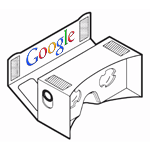
When Google first introduced Cardboard VR earlier at its 2014 I/O event, most people misunderstood it
People have wondered how a piece of cutout cardboard to place a smartphone inside it could possibly become a proper virtual reality headset. VR has been popular with brands like Oculus Rift and Samsung's Gear VR, and Google's cardboard was seen as more of a fun joke than a serious project.
This is where people had it all wrong.
Google Cardboard, compared to its competitors, is incomparable. From the appearance, it's nothing more than a bunch of cardboard cut and folded to hold a smartphone in front of the user's eyes. It's a lot less interesting than the competitors from the looks of it.
So why did Google continued the fun if the device isn't comparable to Oculus Rift or Gear VR?
Simple as it looks. Cardboard are pretty neat since people can transform one to anything using their imaginations. And that spirit is what made Google's team turn some pieces of heavy-duty papers, and a smartphone, into a VR headset.
What Cardboard does is to make everyone able to experience virtual reality.

On December 10th, 2014, the company announced that it's going to keep the project going with a new Cardboard app Google Play page, an updated SDK for both Android and Unity, and updated specs on the device.
Despite being simple and very much modest product made by a tech giant, the response for the device was delightful. The Mountain View company said that it was able to ship 500,000 units, or just a few thousand units more than the giveaways to the attendees at the I/O event.
"We really didn't expect it," said Andrew Nartker, Product Manager for Google's Cardboard division. "We built it mostly for hobbyists and enthusiasts like ourselves, for the maker community. That was really the intention, to put the knowledge and tools in the hands of makers."
And when Google said that the fun isn't over, the company has been working to improve Cardboard ever since. The company is not done quite yet on building the platform. With half a million sold, Google is starting a new round of updates for users, developers, and makers. And this is the milestone where Google is getting quite serious about virtual reality.
"All of this is wrapped up in an easier user experience," said Nartker. "It's easier for people to find and discover new content."
With the new SDK, the tools that Nartker says will allow anyone to create immersive VR experiences. Apps for Cardboard should work on any VR headsets powered by Android.
For interested people, they can pick one from DODOcase, I Am Cardboard, Knoxlabs, and Unofficial Cardboard. And because the concept of Cardboard is creating a device out of pieces of cardboards, people can always build one on their own.
The new specifications include richer design templates and more detailed manufacturing tips. There's a viewer calibration tool which makers can use to ensure their homemade headsets will work well with Cardboard-compatible apps.
"This way anyone can make a Cardboard VR device, make it their own, set their own parameters and make sure the content always works," said Nartker. "Cardboard is good enough for the story we wanted to tell."